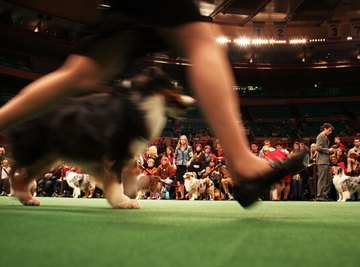
Middle school science fairs are an opportunity for sixth, seventh and eighth grade students to explore scientific questions in depth and get their first experiences in research and the scientific method. Assuming your school or district's science fair rules permit experiments involving dogs, your household pet can be a great subject for scientific inquiry. If your science fair does not allow using dogs in experiments, you can still use dog show results or other dog facts for a research-based project.
Can Dogs See Color?
Design an experiment to determine if your dog can differentiate between colors. First, make a hypothesis as to whether or not you believe your dog can see colors. Then, create a way to test that hypothesis. For example, you may get a red tennis ball and a green tennis ball. If your dog chooses the red tennis ball, he gets a small treat. Continue to offer him the choice of a red or green tennis ball and see if he begins to choose the red tennis ball consistently to earn the treat. Keep track of his choices each time and the number of attempts. Report on your findings and whether or not they confirm your hypothesis.
Can Dog Saliva Kill Bacteria?
Old wives' tales claim that dog saliva can kill bacteria and that a dog's mouth is cleaner than a human's. You can test these theories with a simple experiment. Obtain bacteria, whether through mail order from a lab or from around your home or school. Grow the bacteria in a petri dish using agar and measure its rate of growth. Obtain saliva from a dog or multiple dogs and place that saliva in the petri dish to evaluate if it stops the growth of the bacteria. To compare with a human mouth, test saliva from a human in another petri dish of bacteria. Keep a control petri dish with bacteria whose growth you do not attempt to slow with saliva for comparison. Report on your results.
Can You Predict Dog Show Winners?
For an experiment that does not require the use of live dogs, you can research whether certain breeds, genders or ages of dogs are more likely to win dog show awards. Choose a dog show and analyze the results from past years for patterns. Hypothesize whether the results are due to superiority of certain breeds or judges' bias. Compare results with a different dog show to see if the results are consistent. Determine, if possible, a formula for predicting dog show winners, or report why no such predictions are possible.
Which Dog Food Is Most Easily Digested?
Experimenting with dog food digestibility is not for the squeamish, but makes for a memorable project. Choose two to three different dog foods and predict which ones will be most easily digested based on their ingredients. Enlist several dogs and record in advance their usual number of bowel movements and any information about consistency and odor. Feed each dog each of the dog foods for a week and log their output over that period of time. Photograph and log their waste and categorize it to determine which dog food is most easily digested.
References
Photo Credits
Spencer Platt/Getty Images News/Getty Images
